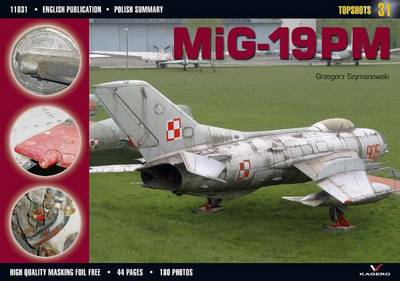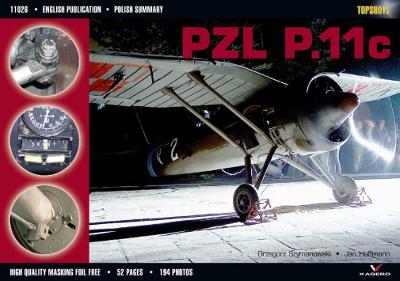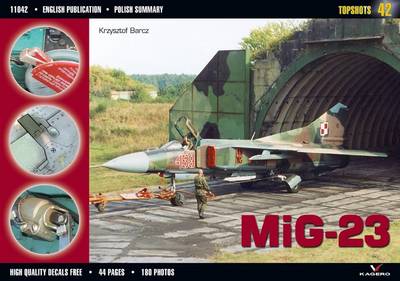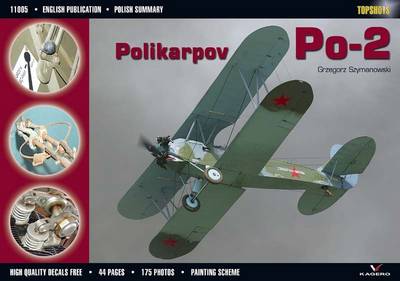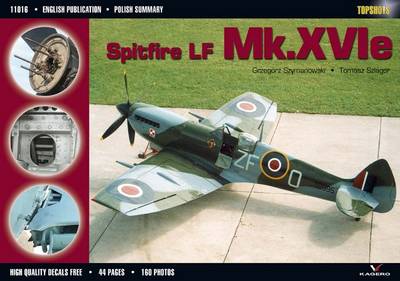Topshots
5 total works
The Mikoyan-Gurevich MiG-19 is a Soviet second-generation, single-seat, twin jet-engined fighter aircraft. It was the first Soviet production aircraft capable of supersonic speeds in level flight.
With the MiG-19PM variant, which entered production in 1957, the cannons were removed, and it was armed with 4× Kaliningrad K-5M beam-riding missiles.
This monograph features many colour detail photos, making it an ideal publication for the modeller.
About the Series
This is a classic series of highly illustrated books on the best machines of war, with several hundred photographs of each aircraft or vehicle. With close-up views of the key features of each machine, including its variations, markings and modifications, customising and creating a model has never been easier. Includes extra features such as decals and masking foil.
With the MiG-19PM variant, which entered production in 1957, the cannons were removed, and it was armed with 4× Kaliningrad K-5M beam-riding missiles.
This monograph features many colour detail photos, making it an ideal publication for the modeller.
About the Series
This is a classic series of highly illustrated books on the best machines of war, with several hundred photographs of each aircraft or vehicle. With close-up views of the key features of each machine, including its variations, markings and modifications, customising and creating a model has never been easier. Includes extra features such as decals and masking foil.
The PZL P.11 was a Polish fighter aircraft, designed in the early 1930s by PZL in Warsaw and briefly considered to be the most advanced fighter aircraft design in the world. The PZL P.11 served as Poland's primary fighter defence in the Polish campaign of 1939, but by that point was outdated due to rapid advances in aircraft design.
The book offers a detailed photographic documentation of the aircraft’s renovation process. All photo captions are in English with a Polish summary provided.
About the Series
This is a classic series of highly illustrated books on the best machines of war, with several hundred photographs of each aircraft or vehicle. With close-up views of the key features of each machine, including its variations, markings and modifications, customising and creating a model has never been easier. Includes extra features such as decals and masking foil.
The book offers a detailed photographic documentation of the aircraft’s renovation process. All photo captions are in English with a Polish summary provided.
About the Series
This is a classic series of highly illustrated books on the best machines of war, with several hundred photographs of each aircraft or vehicle. With close-up views of the key features of each machine, including its variations, markings and modifications, customising and creating a model has never been easier. Includes extra features such as decals and masking foil.
The Mikoyan-Gurevich MiG-23 is a swing-wing fighter aircraft, designed by the Mikoyan-Gurevich bureau in the Soviet Union. It is considered to belong to the Soviet "Third Generation" aircraft category along with similar-aged Russian-produced fighters such as the MiG-25 "Foxbat".
It was the first Soviet fighter with a look-down/shoot-down radar and beyond visual range missiles, and the first MiG production fighter plane to have intakes at the sides of the fuselage.
Production started in 1970 and reached large numbers with over 5,000 aircraft built. Today the MiG-23 remains in limited service with various export customers.
This album of detailed photographs is invaluable for the modeller or enthusiast alike.
About the Series
This is a classic series of highly illustrated books on the best machines of war, with several hundred photographs of each aircraft or vehicle. With close-up views of the key features of each machine, including its variations, markings and modifications, customising and creating a model has never been easier. Includes extra features such as decals and masking foil.
It was the first Soviet fighter with a look-down/shoot-down radar and beyond visual range missiles, and the first MiG production fighter plane to have intakes at the sides of the fuselage.
Production started in 1970 and reached large numbers with over 5,000 aircraft built. Today the MiG-23 remains in limited service with various export customers.
This album of detailed photographs is invaluable for the modeller or enthusiast alike.
About the Series
This is a classic series of highly illustrated books on the best machines of war, with several hundred photographs of each aircraft or vehicle. With close-up views of the key features of each machine, including its variations, markings and modifications, customising and creating a model has never been easier. Includes extra features such as decals and masking foil.
The Polikarpov Po-2 served as a general-purpose Soviet biplane. The reliable, uncomplicated and forgiving aircraft served as a trainer and crop-duster in peacetime as well as a low-cost ground attack, aerial reconnaissance, psychological warfare and liaison aircraft during war, proving to be one of the most versatile light combat types to be built in USSR.
It is the second most produced aircraft, and the most produced biplane, in the history of aviation, with more than 40,000 built between 1928 and 1953. It remained in production for a longer period of time than any other Soviet-era aircraft.
This album of detailed photographs is invaluable for the modeller or enthusiast alike. All photo captions are in English with a Polish summary provided.
About the Series
This is a classic series of highly illustrated books on the best machines of war, with several hundred photographs of each aircraft or vehicle. With close-up views of the key features of each machine, including its variations, markings and modifications, customising and creating a model has never been easier. Includes extra features such as decals and masking foil.
It is the second most produced aircraft, and the most produced biplane, in the history of aviation, with more than 40,000 built between 1928 and 1953. It remained in production for a longer period of time than any other Soviet-era aircraft.
This album of detailed photographs is invaluable for the modeller or enthusiast alike. All photo captions are in English with a Polish summary provided.
About the Series
This is a classic series of highly illustrated books on the best machines of war, with several hundred photographs of each aircraft or vehicle. With close-up views of the key features of each machine, including its variations, markings and modifications, customising and creating a model has never been easier. Includes extra features such as decals and masking foil.
The Spitfire Mk XVI was the same as the Mk IX in nearly all respects except for the engine, a Merlin 266. All Mk XVI aircraft produced were of the Low-Altitude Fighter variety. This was determined by the engine, which had been optimised for low-altitude operation. All production Mk XVIs had clipped wings for low altitude work and were fitted with the rear fuselage fuel tanks with a combined capacity of 75 gal. Many Mk XVIs featured cut-down rear fuselages with "bubble" canopies. On these aircraft the rear fuselage tank capacity was limited to 66 gal.
This book provides numerous colour photos of this classic aircraft.
About the Series
This is a classic series of highly illustrated books on the best machines of war, with several hundred photographs of each aircraft or vehicle. With close-up views of the key features of each machine, including its variations, markings and modifications, customising and creating a model has never been easier. Includes extra features such as decals and masking foil.
This book provides numerous colour photos of this classic aircraft.
About the Series
This is a classic series of highly illustrated books on the best machines of war, with several hundred photographs of each aircraft or vehicle. With close-up views of the key features of each machine, including its variations, markings and modifications, customising and creating a model has never been easier. Includes extra features such as decals and masking foil.
